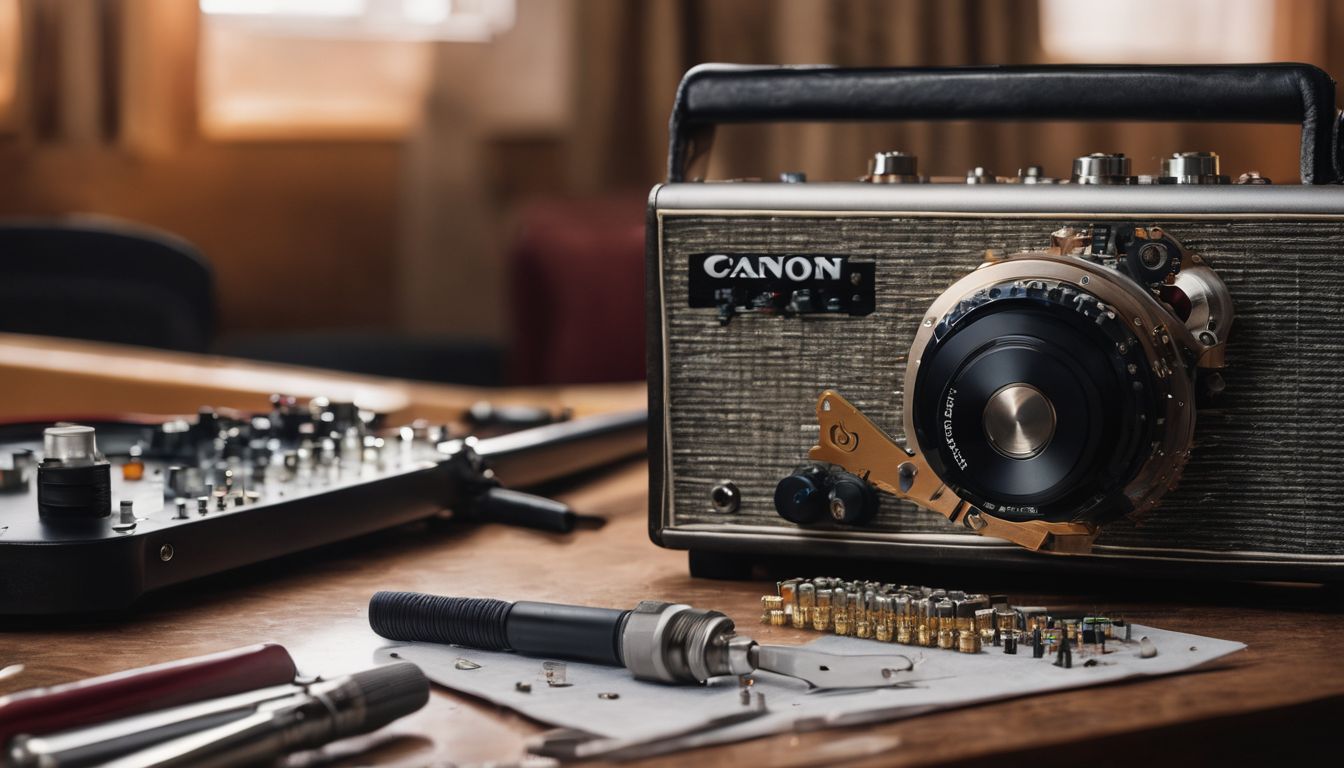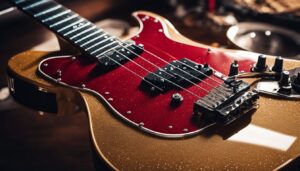As an Amazon Associate I earn from qualifying purchases.
Having trouble with your electric guitar? You’re not alone – many guitar players encounter issues, from hardware malfunctions to intonation problems. This article is here to provide easy-to-follow steps on troubleshooting common electric guitar problems.
Let’s dive into the world of guitar maintenance and smooth out those musical bumps!
Table of Contents
Common Electric Guitar Problems
Hardware issues, such as loose screws or rattling hardware, can affect the playability and tone of an electric guitar. Intonation problems may cause difficulty while fretting or lead to a bad intonation overall.
Tuning stability can be compromised by a loose guitar cable or faulty output jack. Electrical issues like a blown amp tube or malfunctioning pickups can also impact the sound quality of the guitar.
Hardware issues
Loose or rattling hardware can wreak havoc on an electric guitar’s performance. This might lead to issues like difficulty in fretting, Buzzing sounds, and even bad intonation. Guitar parts such as the tuning pegs, string saddles, volume knobs can loose over time due to usage and this frequently leads to a decline in playability and sound quality.
More troubling symptoms include the high E string jumping out of its slot at the nut or your pickguard starting to peel off. Corrosion on metal components is another concern that not only affects aesthetics but also functionality when it occurs on vital parts like pickups or tuners.
A faulty output jack may cause intermittent sound cut-out or noise when you connect your guitar cable – an issue which becomes more pronounced if you have a blown tube in your amplifier.
The good news is with some basic technical skills most of these annoyances can be fixed right at home by tightening connections and replacing worn-out parts.
Intonation problems
Intonation problems can cause frustration when playing the electric guitar. These issues occur when certain notes don’t sound in tune, even when the strings are properly tuned. One common intonation problem is when the high E string jumps out of the nut while playing higher up on the neck.
This can be caused by an improperly cut or worn-out nut, which may need to be replaced. Another intonation issue is when some fretted notes sound sharp or flat compared to open strings or harmonics.
Adjusting the saddle position on the bridge can help solve this problem and ensure that all notes are in tune across all frets.
Tuning stability
To maintain tuning stability on your electric guitar, there are a few things you can do. First, check the strings’ condition and make sure they are properly installed and stretched out.
If they’re old or worn, it may be time to replace them. Next, examine the nut and bridge to ensure the strings are properly seated in their slots without any binding or excess friction.
Tighten any loose screws or bolts on the tuners to keep them secure. Additionally, consider using locking tuners or a locking system at the bridge for more stability during heavy playing or string bending.
Electrical issues
If you are experiencing electrical issues with your electric guitar, there are a few common problems that could be causing the problem. Loose cables or faulty output jacks can cause sound issues or even no sound at all.
If you notice buzzing or rattling sounds, it may be due to loose connections in the wiring. Another issue to watch out for is a blown tube in your amp, which can affect the quality of the sound coming from your guitar.
Troubleshooting these electrical issues will involve checking and repairing wiring, replacing faulty components, and ensuring everything is connected securely.
Troubleshooting and Fixes for Electric Guitar Problems
To troubleshoot and fix common electric guitar problems, follow these steps to ensure your instrument is in optimal playing condition.
Tightening hardware and ensuring proper intonation
To troubleshoot common electric guitar problems, it is important to ensure that the hardware is tightened properly and the intonation is set correctly. Loose screws or fittings can lead to rattling or buzzing hardware, affecting the overall sound quality of your guitar.
By tightening all the connections and ensuring a secure fit for components like tuners, bridge saddles, and pickguards, you can eliminate these issues. Additionally, maintaining proper intonation ensures that each note plays in tune along the entire length of the fretboard.
Adjusting saddle positions and string lengths will help fix any problems with bad intonation or high E strings jumping out of the nut. Regularly checking and adjusting these aspects of your guitar’s setup will keep it playing at its best.
Checking and replacing strings
To ensure optimal sound and playability, it’s essential to regularly check and replace the strings on your electric guitar. Start by visually inspecting the strings for signs of wear or damage, such as fraying or discoloration.
Next, tune each string to its proper pitch using a reliable tuner. If you encounter any issues while tuning, such as difficulty keeping the string in tune or hearing buzzing sounds, it may be time to replace that particular string.
When replacing the strings, make sure to securely fasten them at both ends by tying tight knots or using appropriate tools like bridge pins or locking nuts. Regularly changing your guitar strings will help maintain a crisp and vibrant tone while preventing potential problems down the line.
Cleaning and maintaining electrical components
To ensure optimal performance of your electric guitar, it is important to regularly clean and maintain its electrical components. Start by gently wiping down the pickups, switches, and potentiometers with a soft cloth to remove any dust or debris.
Use compressed air or a small brush to clean hard-to-reach areas. Additionally, inspect all the wiring connections for loose or corroded contacts. Clean them using contact cleaner and reconnect securely.
Regular maintenance will help prevent issues like crackling sounds or intermittent signal loss that can arise from dirty or faulty electrical components.
Checking and repairing wiring
To ensure your electric guitar is functioning properly, it’s important to regularly check and repair any wiring issues. Faulty wiring can cause a variety of problems, including a lack of sound or distorted output.
Start by carefully inspecting all the wires and connections for any signs of damage or loose connections. If you discover any issues, such as frayed wires or loose solder joints, you can easily fix them with some basic electrical skills and tools.
Remember to use proper insulation techniques when repairing or replacing wires to prevent future problems. By taking the time to check and repair your guitar’s wiring, you can ensure optimal performance and playability.
Seeking Professional Help
If DIY fixes aren’t working or if you don’t have the technical skills to troubleshoot and fix the issues yourself, it’s important to know when to consult a guitar technician or luthier for professional help.
When DIY fixes aren’t working
If your attempts to fix the issues with your electric guitar aren’t yielding any results, it may be time to consider seeking professional help. Sometimes, certain problems require technical skills or knowledge that may be beyond what you can handle on your own.
A guitar technician or luthier will have the expertise to diagnose and resolve complex issues with your instrument. Don’t hesitate to reach out for assistance when you’ve exhausted all DIY options and need an expert’s touch to get your guitar back in top shape.
Knowing when to consult a guitar technician or luthier
If you’ve tried troubleshooting your electric guitar problems on your own and they persist, it might be time to bring in a professional. A guitar technician or luthier has the knowledge and expertise to diagnose and fix more complex issues that may require specialized tools or technical skills.
Whether you’re dealing with buzzing hardware, bad intonation, or faulty electronics, a professional can help ensure your guitar is performing at its best. Don’t hesitate to seek their assistance if DIY fixes aren’t working – they have the experience needed to get your instrument back in top shape.
Conclusion
In conclusion, troubleshooting common electric guitar problems requires some technical skills and knowledge. By identifying hardware issues, intonation problems, tuning stability, and electrical issues, you can take steps to fix them yourself or seek professional help when needed.
With proper maintenance and occasional repairs, you can keep your electric guitar in great playing condition for years to come.
FAQs
1. How do I fix a buzzing sound coming from my electric guitar?
A buzzing sound on an electric guitar can usually be fixed by adjusting the string height or checking and tightening any loose parts, such as the tuning pegs or bridge.
2. What should I do if my electric guitar won’t stay in tune?
If your electric guitar won’t stay in tune, check if the strings are properly wound around the tuning pegs and make sure they are not old or worn out. It may also help to lubricate the nut slots with graphite or use locking tuners for better stability.
3. How can I troubleshoot an issue with low output volume on my electric guitar?
To troubleshoot low output volume on an electric guitar, start by checking if your pickups are properly adjusted and not too far away from the strings. You should also inspect all wiring connections to ensure there is no loose connection or faulty solder joint.
4. What should I do if my electric guitar produces a crackling sound?
If your electric guitar produces a crackling sound, try cleaning the input jack with contact cleaner and check that all cables are securely plugged in. If the issue persists, it may be necessary to have a professional examine and repair any faulty components like pots or switches.
Amazon and the Amazon logo are trademarks of Amazon.com, Inc, or its affiliates.





